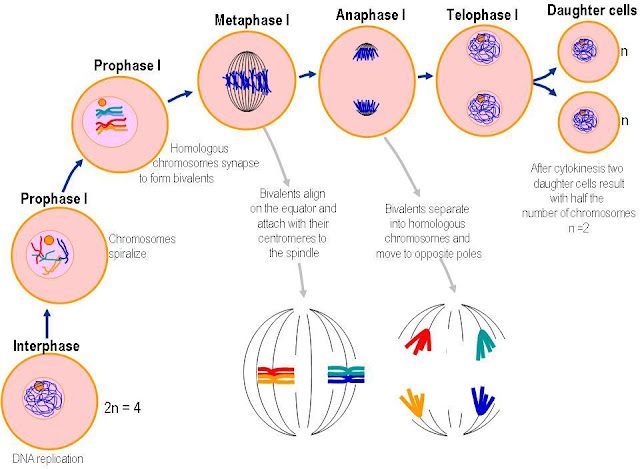🔬 MITOSIS – “Making Identical Cells”
🔄 What is Mitosis?
Mitosis is a single cell division that creates two identical daughter cells, each with the same number of chromosomes as the parent cell.
Used for growth, repair, and asexual reproduction.
🧪 Mitosis Process:
- Prophase – Chromosomes condense, spindle fibers form.
- Metaphase – Chromosomes line up in the middle.
- Anaphase – Sister chromatids are pulled apart.
- Telophase – Two new nuclei form.
- Cytokinesis – The cell splits.
✅ Product:
- 2 diploid cells (2n)
- Genetically identical to each other and to the parent cell.
🔍 What is Meiosis?
Meiosis is a type of cell division that reduces the number of chromosomes by half. It's how sex cells (gametes) — sperm in males and eggs in females — are made.
Think of it like splitting a full pizza (with 46 slices = chromosomes) into two smaller pizzas with only 23 slices each. This is necessary so that when fertilization happens, the full pizza (46 chromosomes) is restored!
🧬 Why is Meiosis Important?
- It produces gametes for sexual reproduction.
- It ensures that offspring have the correct number of chromosomes.
- It introduces genetic variation, which is important for evolution and survival.
🧩 Chromosome Numbers Recap
- Humans have 46 chromosomes in body cells → these are diploid (2n).
- Gametes (sperm/egg) have 23 chromosomes → these are haploid (n).
🔄 Two Main Stages of Meiosis:
Meiosis happens in two parts:
- Meiosis I – Reduces chromosome number.
- Meiosis II – Similar to mitosis, separates chromatids.
We’ll break them down step by step.
🔬 Meiosis I – Reduction Division
➤ Prophase I
- Chromosomes condense (they become visible under a microscope).
- Homologous chromosomes pair up (these are chromosomes with the same genes from mom and dad).
- Crossing over occurs – they exchange pieces of DNA.
🧠 Why it matters: This creates genetic variation – like shuffling a deck of cards.
➤ Metaphase I
- Homologous pairs line up at the equator of the cell (middle).
- Independent assortment – The way they line up is random, creating different combinations.
➤ Anaphase I
- Homologous chromosomes are pulled to opposite poles (ends of the cell).
- Chromatids stay together.
➤ Telophase I
- A nuclear membrane forms around each set of chromosomes.
- The cell splits by cytokinesis.
- We now have 2 haploid cells with half the chromosome number.
🔁 Meiosis II – Like Mitosis
Now we go into a second division. Remember, we started with one cell and now we have 2 haploid cells.
➤ Prophase II
- New spindle forms.
- Nuclear membranes disappear.
➤ Metaphase II
- Chromosomes line up in the middle (equator) again.
➤ Anaphase II
- Sister chromatids are pulled apart to opposite ends.
➤ Telophase II
- Nuclear membranes reform.
- Each cell splits again.
🎉 We end with 4 genetically different haploid cells!
🌟 Key Concepts to Remember
| Term | Meaning |
|---|---|
| Haploid (n) | Half the chromosome number (23 in humans) |
| Diploid (2n) | Full set of chromosomes (46 in humans) |
| Crossing over | Exchange of genetic material between homologous chromosomes |
| Independent assortment | Random alignment of chromosomes during metaphase I |
| Gametes | Sex cells (sperm/egg) produced through meiosis |
📊 Differences Between Meiosis & Mitosis
| Feature | Meiosis | Mitosis |
|---|---|---|
| Number of divisions | 2 | 1 |
| Cells formed | 4 haploid cells | 2 diploid cells |
| Genetic variation | Yes | No (identical cells) |
| Occurs in | Sex organs (testes, ovaries) | All body cells |
| Purpose | Sexual reproduction | Growth & repair |
🤓 Tips to Understand Meiosis Better
🔁 Meiosis = 2 divisions
🧩 Crossing over + Independent assortment = Variation
🧬 Haploid gametes + Haploid gametes = Diploid zygote
✅ Summary
- Meiosis is how we make gametes.
- It ensures each gamete has half the chromosomes.
- It adds variation, which helps with survival.
- The process goes: Meiosis I (reduction) → Meiosis II (separation) → end up with 4 different cells.
.png)





.png)
.png)

No comments:
Post a Comment